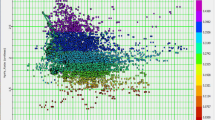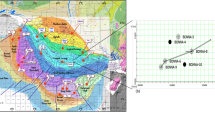Abstract
Lithofacies identification and sand quality discrimination play key roles in the illumination of reservoir properties and reducing the uncertainties associated with the hydrocarbon reservoir characterization. In this study, prestack Poisson impedance inversion (PI) and Poisson dampening factor (PDF) attributes are used to identify lithofacies and discriminate zones with different sand qualities in the Ghar reservoir in an Iranian oilfield. A combination of well-logs and prestack seismic gathers is used to solve the prestack simultaneous inversion matrix. P- and S-wave velocities and the density of the rocks are the information extracted from prestack simultaneous inversion. This information is used to generate the PDF and PI attributes. The C-value corresponding to the maximum correlation coefficient for gamma ray is used to compute the PI attribute. To estimate an accurate C-value, target correlation coefficient analysis (TCCA) is used. A cross-plot of the PDF and PI is used to evaluate zones with different sand quality in the Ghar reservoir. Results based on lithology cutoff showed samples with low values of Poisson impedance (< 700 (m/s*g/cc)) are indicative of a clean hydrocarbon sand zone. In the zone of interest, high values of PDF (> 0.00035 ((m/s)/m*(cc/g))) and low values of PDF (< 0.00028 ((m/s)/m*(cc/g))) are indicators of high- and low-quality sand, respectively. Using a PDF vs. gamma-ray cross-plot, four classifications of lithofacies are identified at well locations: clean hydrocarbon zone, shaley sand zone, sandy shale zone, and shale zone. We have also detected a northwest-southeast channel and a hydrocarbon zone in the northwest of the studied area. The described approach will help to locate new sites for drilling future infill wells in areas where there is no well control.










Similar content being viewed by others
References
Alavi M (2004) Regional stratigraphy of the Zagros fold-thrust belt of Iran and its proforeland evolution. Am J Sci 304(1):1–20
Alebouyeh M, Chehrazi A (2018) Application of extended elastic impedance (EEI) inversion to reservoir from non-reservoir discrimination of Ghar reservoir in one Iranian oil field within Persian Gulf. J Geophys Eng 15(4):1204–1213
Anggraeni W, Mulyatno BS, Sarkowi M, Nursina MI, and Syafriya A (2018) 3D pre-stack simultaneous inversion and lame parameter extraction applied to discriminate the lithology and pore-fluid: case study: Gumai Formation, Jambi Sub-Basin, South Sumatra. In SEG Technical Program Expanded Abstracts 2018 (pp. 655–658). Society of Exploration Geophysicists
Atashbari V, Tingay M, Amrouch K (2018) Stratigraphy, tectonics and hydrocarbon habitat of the Abadan plain basin: a geological review of a prolific middle Eastern Hydrocarbon Province. Geosci 8(12):496
Chopra S, Castagna JP (2014) Avo. Society of Exploration Geophysicists, Tulsa
Cranganu C (2013) Natural gas and petroleum: production strategies, environmental implications, and future challenges. Nova Publishers
Direzza A, and Permana I K A A, (2012) PSThe application of poisson impedance inversion for sandstone reservoir characterization in the Lower Talang Akar Formation, Case Study Melandong-West Java
Fatti JL, Smith GC, Vail PJ, Strauss PJ, Levitt PR (1994) Detection of gas in sandstone reservoirs using AVO analysis: a 3-D seismic case history using the Geostack technique. Geophysics 59(9):1362–1376
Goodway B, Chen T, and Downton J (1997) Improved AVO fluid detection and lithology discrimination using Lamé petrophysical parameters; “λρ”,“μρ”, and “λ/μ fluid stack”, from P and S inversions. In SEG technical program expanded abstracts 1997 (pp. 183–186). Society of Exploration Geophysicists
Hampson D P, Russell B H, and Bankhead B (2005) Simultaneous inversion of pre-stack seismic data. In SEG Technical Program Expanded Abstracts 2005 (pp. 1633–1637). Society of Exploration Geophysicists
Haris A, Nenggala Y, Suparno S, Raguwanti R, and Riyanto A (2017, July) Characterization of low contrast shale-sand reservoir using Poisson impedance inversion: Case study of Gumai formation, Jambas field Jambi Sub-basin. In AIP Conference Proceedings (Vol. 1862, No. 1, p. 030188). AIP Publishing LLC
He W, Hao J, Yang J, Guan X, Dai R, Li Y (2019) Application of pre-stack simultaneous inversion to predict gas-bearing dolomite reservoir: a case study from Sichuan Basin. China Carbonates and Evaporites 34(3):1191–1201
Hosseini Shoar B, Javaherian A, Farajkhah NK, Arabani MS (2013) Appraisal of gas hydrate resources based on a P-and S-impedance reflectivity template: case study from the deep sea sediments in Iran. J of Geophys and Eng 10(6):065006
Hutahaean R A, Rosid M S, Guntoro J and Ajie H (2018, October). Poisson impedance analysis to identify sweet spot shale gas reservoir in field “X”. In AIP Conference Proceedings (Vol. 2021, No. 1, p. 040004). AIP Publishing LLC.
Jafari M, Nikrouz R, Kadkhodaie A (2017) Estimation of acoustic-impedance model by using model-based seismic inversion on the Ghar Member of Asmari Formation in an oil field in southwestern Iran. Lead Edge 36(6):487–492
Khitrenko A, Binkov K, and Garina K (2018, June) Poisson impedance for Achimov formation sandstone reservoirs characterization. In 80th EAGE Conference and Exhibition 2018 (Vol. 2018, No. 1, pp. 1–5). European Association of Geoscientists and Engineers
Ma XQ (2002) Simultaneous inversion of prestack seismic data for rock properties using simulated annealing. Geophysics 67(6):1877–1885
MansouriSiahgoli H, Riahi MA, Heidari B, Mohebian R (2020) Identifying gas-bearing carbonate reservoir using extended elastic impedance. Iran J of Oil and Gas Sci and Technol 9(3):102–115
Mazumdar P (2007) Poisson dampening factor. Lead Edge 26(7):850–852
Moghanloo HG, Riahi MA, Bagheri M (2018) Application of simultaneous prestack inversion in reservoir facies identification. J Geophys Eng 15(4):1376–1388
Okeugo CG, Onuoha KM, Ekwe CA, Anyiam OA, Dim CIP (2019) Application of crossplot and prestack seismic-based impedance inversion for discrimination of lithofacies and fluid prediction in an old producing field, Eastern Niger Delta Basin. Journal of Petroleum Exploration and Production Technology 9(1):97–110
Prakash P, Singh S K, Chetia B, Chaudhuri P K, Mohan S and Das S K (2012) Application of advanced tools for reservoir characterization-EEI and Poisson impedance: a case study. GEOHORIZONS, January, 50–55
Quakenbush M, Shang B, Tuttle C (2006) Poisson impedance. Lead Edge 25(2):128–138
Russell BH (2014) Prestack seismic amplitude analysis an integrated overview. Interpretation 2(2):SC19–SC36
Sharma RK, Chopra S (2013) Poisson impedance inversion for characterization of sandstone reservoirs. In 2013 SEG Annual Meeting. OnePetro
Simm R, Bacon M, Bacon M (2014) Seismic amplitude: an interpreter’s handbook. Cambridge University Press
Soleymani H, Riahi MA (2012) Velocity based pore pressure prediction—a case study at one of the Iranian southwest oil fields. J Petrol Sci Eng 94:40–46
Tian L, Zhou D, Lin G, and Jiang L (2010) Reservoir prediction using Poisson impedance in Qinhuangdao, Bohai Sea. In 2010 SEG Annual Meeting. OnePetro
Tian L (2014) Applications of Poisson damping factor (PDF) in the detection of marine reservoir fluids. In 76th EAGE Conference and Exhibition 2014 (Vol. 2014, No. 1, pp. 1–5). European Association of Geoscientists and Engineers
Wang L, Zheng X, Guo W, He W, and Xu J (2017) Effective method of seismic reservoir characterization using normalized Poisson impedance and λρ attribute. In SEG Technical Program Expanded Abstracts 2017 (pp. 3047–3051). Society of exploration geophysicists
Whitcombe DN, Connolly PA, Reagan RL, Redshaw TC (2002) Extended elastic impedance for fluid and lithology prediction. Geophysics 67(1):63–67
Zhang J, Guo X, Xu B, Wang X, Shen P, and Chen S (2019) Application of pre-stack simultaneous inversion on the reservoir identification and fluid prediction: a case history of Es2 member reservoir in Shengli Oilfield. In IOP Conference Series: Earth and Environmental Science (Vol. 227, No. 6, p. 062003). IOP Publishing.
Zhou Z, Hilterman FJ (2010) A comparison between methods that discriminate fluid content in unconsolidated sandstone reservoirs. Geophysics 75(1):B47–B58
Acknowledgements
Thanks are given to anonymous domain experts for their input and insight without which this research would not have been possible. The authors would like to acknowledge The Research Council of the University of Tehran.
Author information
Authors and Affiliations
Corresponding author
Ethics declarations
Conflict of interest
The authors declare that they have no competing interests.
Additional information
Responsible Editor: Narasimman Sundararajan.
Rights and permissions
About this article
Cite this article
Ghanbarnejad Moghanloo, H., Riahi, M.A. Application of prestack Poisson dampening factor and Poisson impedance inversion in sand quality and lithofacies discrimination. Arab J Geosci 15, 116 (2022). https://doi.org/10.1007/s12517-021-09307-1
Received:
Accepted:
Published:
DOI: https://doi.org/10.1007/s12517-021-09307-1




